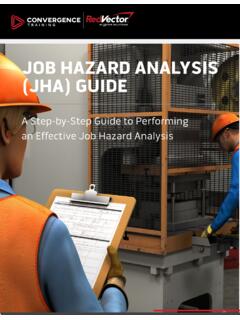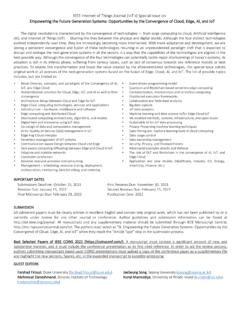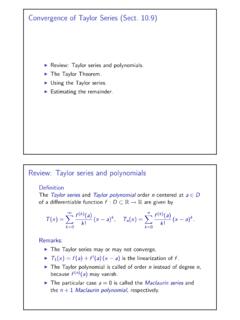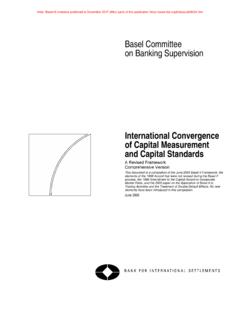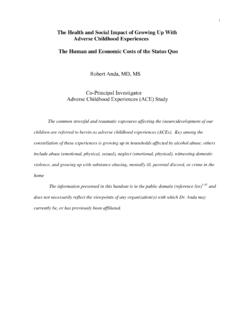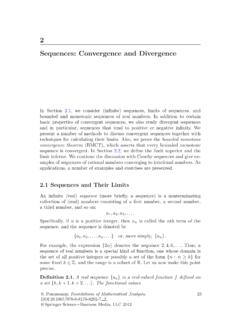Transcription of Convergence of Numerical Methods
1 Chapter 2 Convergence of Numerical MethodsIn the last chapter we derived the forward Euler method from aTaylor series expansion ofun+1and we utilizedthe method on some simple example problems without any supporting analysis. This chapter onconvergencewillintroduce our first analysis tool in Numerical Methods for the solution of Self-AssessmentBeforereading this chapter, you may wish to limits [ Lecture 2: Video]Afterreading this chapter you should be able list the two primary sources of error in the Numerical solution of ODEs describe the concept of Convergence of a Numerical method discuss the relationship between global order of accuracyand the rate of Convergence of a Numerical method evaluate the global order of accuracy of a method from experimental data7 Types of errors in the Numerical solution of ODEsWhen we approximate the solution of ODEs numerically, there are two primary sources of error: rounding (or floatingpoint) errors and truncation errors.
2 Rounding errors are associated to the floating-point arithmetic that our computersuse to perform calculations. Truncation errors, on the other hand, are errors we incur based on the Numerical method;these errors would exist even in the absence of rounding errors. To some extent, we cannot control rounding errors(they are determined by the precision of the machine), but wecan control truncation are truncation errors introduced in the forward Euler method (7)?(a) Taylor series approximation ofun(b) Taylor series approximation ofun+1(c) Taylor series approximation ofunt(d) none of the above788 ConvergenceOne important property of Numerical Methods related to truncation errors isconvergence. In Exercise 3 you experi-mented with the forward Euler method for various time steps tand observed the error at timet=1. You may havenoticed that as you decreased t, the errors also decreased. In the limit as t 0, this behavior is representative 1 ( Convergence ).
3 A Numerical scheme for solvingut=f(u,t),u(0) =u0,0<t T(9)isconvergentifmaxn {0,1,..,T/ t}|vn un| 0as t 0.(10)This is a mathematically precise definition of what you observed for the forward Euler method in Exercise 3. Let stake a moment to investigate Definition 1 a little more deeply. The first part of the statement is familiar by now; we aresolving a first-order ODE of the formut=f(u,t)with given initial conditions. We assume that a method is defined toproduce our Numerical solutionvnforn=1,2,..,T/ t(we assignv0=u0); , the forward Euler words, the Convergence statement is as follows: If we shrink the time step smaller and smaller, the largest absoluteerror between the Numerical solution and the exact solutionwill also get smaller and smaller. For any numericalsolution, the absolute error can be measured at each of the time indicesn=0,1,..,T/ t: that is given by|vn un|.
4 Thus, for any Numerical solution, we can also define the maximum absolute error over those time indices: that is writtenmaxn {0,1,..,T/ t}|vn un|. This is the worst case error for the Numerical solution. If we drive the largest absolute errorto zero, it is implied that the error at each time index will also be driven to summarize, our Convergence statement says that in the limit t 0, the Numerical solution collapses onto theexact solution and the error goes to zero at all time is important to note that in the limit t 0, the lasttime indexT/ t even for finiteT; the time interval between adjacent Numerical solution points(tn,vn)and(tn+1,vn+1)is also shrinking to zero. So not only does our Numerical solution approach zero error at the time stepst0,t1,.., these time steps are getting closer and closer together so that the ordered pairs(t0,v0);(t1,v1);..make upthe entirety of the exact continuous solutionu(t).
5 Video explaining definition of convergence9 Rate of Convergence (Global Order of Accuracy)In addition to knowing whether a Numerical method will converge, we are also interested to know at whatratewillit converge. Therate of convergenceis known as theglobal order of accuracyand describes the decrease in errormaxn {0,1,..,T/ t}|vn un|one can expect for a given decrease in time step tin the limit t 2 (Global order of accuracy).Assume that the forcing functionf(u,t)is sufficiently smooth. (In partic-ular, we needf(u,t)to havepcontinuous derivatives, , up to and including pf/ tpand pf/ up.) A numericalmethod has a global order of accuracypifmaxn {0,1,..,T/ t}|vn un| O( tp)as t 0.(11)This is the second time we ve come across theO( )notation (see (4)). Recall that this means that the terms on theright side of the expression maxn {0,1,..,T/ t}|vn un| O( tp)can be accurately approximated byc tpfor someconstantcin the limit t 0.
6 That is, terms of the form tqforq>pcan be safely ignored since they are muchsmaller in magnitude than tpin the limit t s consider the meaning of this statement in more depth. If a method has global order of accuracyp, in the limit t 0, if we shrink the time step by a factor of two, we can expect the worst case error in the approximation todecrease by a factor of 2p. Therefore, the higher the global order of accuracy, the faster the Convergence rate of thenumerical method. For a first-order accurate method (p=1), we expect that decreasing the time step by a factor of two9(cutting it in half) would result in the halving of the worst case error. Likewise, for a second-order accurate method(p=2), decreasing the time step by a factor of two should lead to the quartering of the worst case error. (It is importantto remember that these statements only hold in the limit t 0. You will find that these results hold approximatelyfor small t, but as you increase tyou will likely not observe this behavior.)
7 We will now demonstrate this behavior numerically for the forward Euler demonstrate the ideas of global accuracy, we will consider an ODE withf= u2and an initial condi-tion ofu(0) =1. The solution to this ODE isu= (1+t) 1. Now, let us apply the forward Euler method to solving thisproblem fort=0 to 10. The approximate solutions for a range of tare shown Figure 2 along with the exact forward Euler solutions are clearly approaching the exact solution as 2 Forward Euler solution forut= u2withu(0) =1 with t= , , and Forward Euler (symbols) and exact solution (line)are shown in first plot. Error is shown in second the plots above to determine the global order of accuracyfor the forward Euler method.(a)p=0(b)p=1(c)p=2(d) none of the abov










